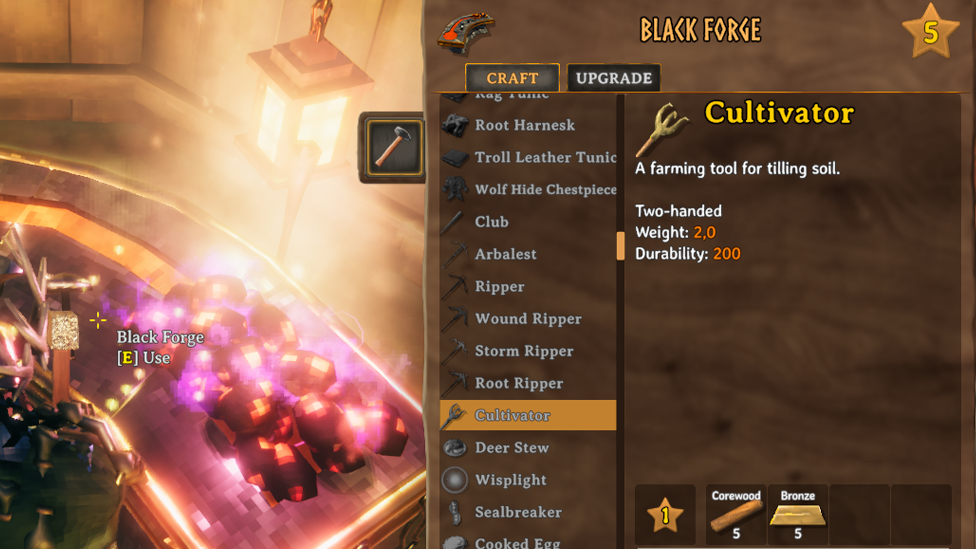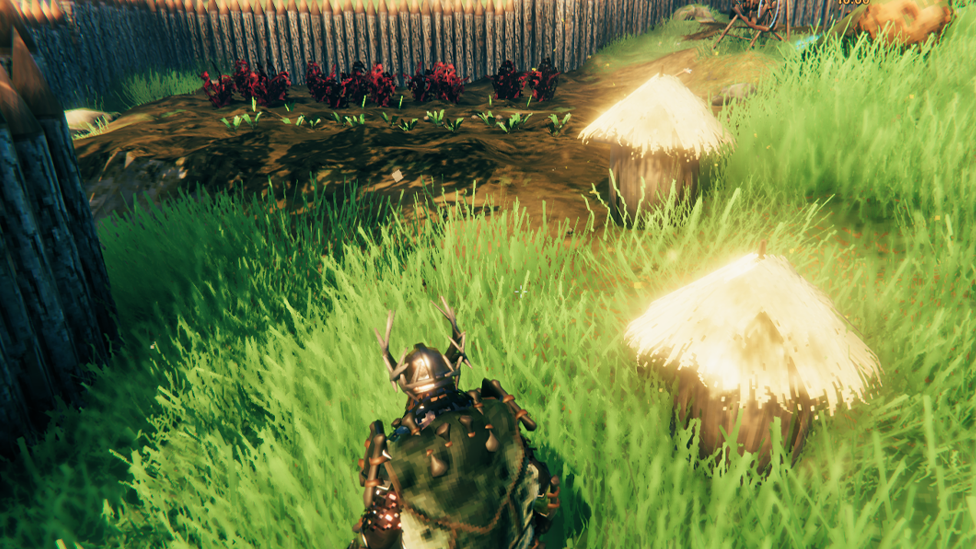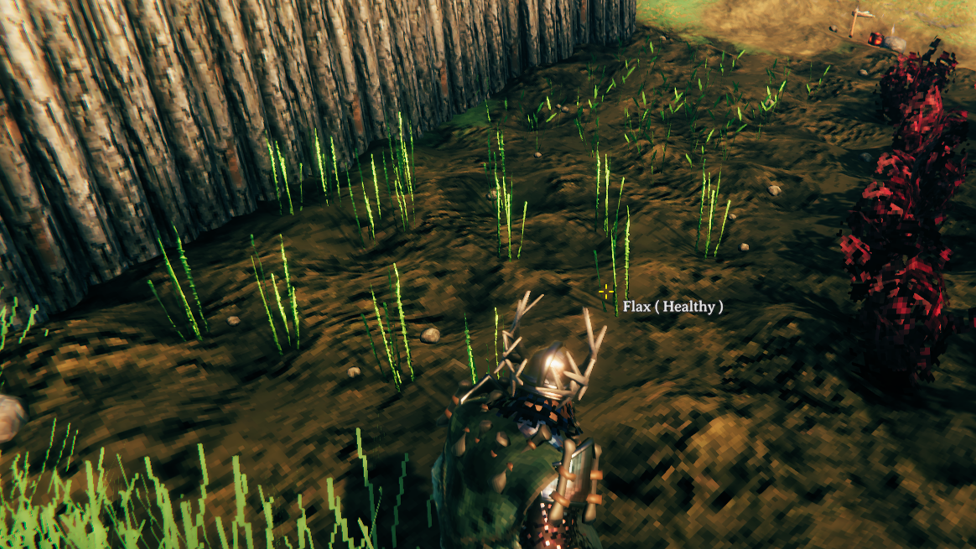How to Farm in Valheim
Farming in Valheim is a must for survival and progression in the game. It is an important component of keeping food to sustain yourself while remaining strong enough to weather the many trials and tribulations of this Viking-inspired survival game. So, this guide will walk you through every step of farming in Valheim, from preparing your land to farming your crops and managing your resources.
How to farm in Valheim?

If you want to start farming in Valheim, you’ll need a Cultivator first. This is the most important tool that you will ever need as it will let you till the soil and plant seeds in Valheim. To make a cultivator, you need bronze, which you can forge by smelting copper and tin. This will require a Smelter and a Forge, both of which are obtained after killing the first boss, Eikthyr, and picking up Surtling Cores from dungeons in the Black Forest. You can convert untamed land into fertile plots to be planted with a Cultivator in hand.
Choosing Crops and Gathering Seeds
There are a lot of crops available in the game, each with its biomes and conditions of growth. The first crops that you grow are carrots, turnips, onions, barley, and flax; they all have an important role to play in your farming plan. In Valheim's Black Forest, there are carrot seeds, the Swamp has turnip seeds, and the Mountains have onion seeds. However, barley and flax are only found in the Plains biome and are often found in Fuling villages.
All crops need space and sunlight to grow. Do not plant the seeds too close together; otherwise, you'll not get healthy yields. Hovering over Planted crops in Valheim will show their growth status with a “Healthy” tag where conditions are optimal. Growth cycles for a crop vary from one to two hours of game time, depending on the crop.
Selecting Farming Locations
Farming success is all in biome selection. Crops such as carrots and turnips can survive in more than one biome, but barley and flax are restricted to the Plains. Jotun Puffs and Magecaps (native to the Mistlands) need some advanced Valheim farming planning, as these biomes are hostile and have little arable land.
You also need to secure your farm. In hostile biomes like the Plains and the Mistlands, fences or trenches are built to protect crops from enemies and environmental hazards.
Expanding Your Farm
In order to be as efficient as possible, you should replant half of your harvest as seeds to keep your farm sustainable. For example, the seeds from carrots and turnips can be planted again, and barley and flax will multiply directly when harvested. Some of the crops in Valheim are not seeded with seeds, so barley and flax need to be replanted to continue.
Other farming elements, such as beehives, are incorporated to increase productivity. Honey is a very useful crafting material for mead and a basic requirement for more advanced recipes in Valheim. To keep a hive, a Queen Bee has to be established by destroying wild hives in an abandoned house.

Efficient Farming Practices
Farming food crops in Valheim and crafting resources must be balanced. Barley and flax are indispensable for advanced crafting and producing flour and linen thread. When you’re trying to upgrade weapons or build a durable structure, these crops are your priority.
The Valheim Cultivator should be utilized very well. Make plots in a flat, open place free from obstructions. Rotate the crops to keep a steady source of food and resources. In addition, set aside areas for other rare crops like Magecaps and Jotun Puffs, which need certain biomes and a good bit of space to grow.
Farming Tips and Tricks
Time Your Harvests
Grown crops take 1–2 in-game Valheim hours, so you need to check your farm and harvest when the crops are ready. Immediate replanting means your production cycle goes continuously, and resources stay easily available for creating staples like barley flour or flax thread.
Expand Gradually
In safe biomes such as Meadows, start farming simple crops such as carrots and turnips. After you’ve got the mechanics down, move on to challenging crops like barley and flax in the Plains. Managing your Valheim farm gradually gives you the ability to manage your farm better, diversify into honey or tree farming, and get a balance between food and crafting resources.

FAQs
Conclusion
Farming in Valheim is a rewarding pastime, but it takes preparation, strategy, and careful management. In order to build a farm that will support your Viking's journey through the game, you craft the right tools, pick appropriate crops, and learn about the biome-specific requirements. It’s also vital for farming, building, and progression.
If you’re looking to increase your Valheim farming experience? ScalaCube provides a great service to rent a Valheim server so that you and your friends can have a great time playing multiplayer. Read more at ScalaCube Valheim Servers.
How to farm in Valheim?

Make Your Own Valheim Server
If you want to start farming in Valheim, you’ll need a Cultivator first. This is the most important tool that you will ever need as it will let you till the soil and plant seeds in Valheim. To make a cultivator, you need bronze, which you can forge by smelting copper and tin. This will require a Smelter and a Forge, both of which are obtained after killing the first boss, Eikthyr, and picking up Surtling Cores from dungeons in the Black Forest. You can convert untamed land into fertile plots to be planted with a Cultivator in hand.
Choosing Crops and Gathering Seeds
There are a lot of crops available in the game, each with its biomes and conditions of growth. The first crops that you grow are carrots, turnips, onions, barley, and flax; they all have an important role to play in your farming plan. In Valheim's Black Forest, there are carrot seeds, the Swamp has turnip seeds, and the Mountains have onion seeds. However, barley and flax are only found in the Plains biome and are often found in Fuling villages.All crops need space and sunlight to grow. Do not plant the seeds too close together; otherwise, you'll not get healthy yields. Hovering over Planted crops in Valheim will show their growth status with a “Healthy” tag where conditions are optimal. Growth cycles for a crop vary from one to two hours of game time, depending on the crop.
Selecting Farming Locations
Farming success is all in biome selection. Crops such as carrots and turnips can survive in more than one biome, but barley and flax are restricted to the Plains. Jotun Puffs and Magecaps (native to the Mistlands) need some advanced Valheim farming planning, as these biomes are hostile and have little arable land.You also need to secure your farm. In hostile biomes like the Plains and the Mistlands, fences or trenches are built to protect crops from enemies and environmental hazards.
Expanding Your Farm
In order to be as efficient as possible, you should replant half of your harvest as seeds to keep your farm sustainable. For example, the seeds from carrots and turnips can be planted again, and barley and flax will multiply directly when harvested. Some of the crops in Valheim are not seeded with seeds, so barley and flax need to be replanted to continue.Other farming elements, such as beehives, are incorporated to increase productivity. Honey is a very useful crafting material for mead and a basic requirement for more advanced recipes in Valheim. To keep a hive, a Queen Bee has to be established by destroying wild hives in an abandoned house.

Efficient Farming Practices
Farming food crops in Valheim and crafting resources must be balanced. Barley and flax are indispensable for advanced crafting and producing flour and linen thread. When you’re trying to upgrade weapons or build a durable structure, these crops are your priority.The Valheim Cultivator should be utilized very well. Make plots in a flat, open place free from obstructions. Rotate the crops to keep a steady source of food and resources. In addition, set aside areas for other rare crops like Magecaps and Jotun Puffs, which need certain biomes and a good bit of space to grow.
Farming Tips and Tricks
- Plan for Biome-Specific Crops Each Valheim crop has its best growth in certain biomes: carrots in the Meadows, barley and flax in the Plains. To make the most out of farming, you want to set up farming bases in the right biomes so that the crops grow efficiently without needing to transport resources. Jotun Puffs and Magecaps, for example, have to be planned well in advance because the Mistlands aren't exactly conducive to their growth, nor are they safe to be in.
- Protect Your Farm Roaming mobs like Fulings and Greydwarves can roam farming areas. Simple fences or trenches around your plots make it difficult for threats to get to your crops. Farms next to fortified bases give you an extra layer of protection and repair defenses quickly after raids to ensure that you can continue productive.
Time Your Harvests
Grown crops take 1–2 in-game Valheim hours, so you need to check your farm and harvest when the crops are ready. Immediate replanting means your production cycle goes continuously, and resources stay easily available for creating staples like barley flour or flax thread.Expand Gradually
In safe biomes such as Meadows, start farming simple crops such as carrots and turnips. After you’ve got the mechanics down, move on to challenging crops like barley and flax in the Plains. Managing your Valheim farm gradually gives you the ability to manage your farm better, diversify into honey or tree farming, and get a balance between food and crafting resources.
FAQs
How do you start farming in Valheim?
You need to till the soil with a Cultivator and plant seeds in suitable biomes. Keep your crops healthy and have plenty of spacing.
What crops can you grow in Valheim?
Players can grow carrots, turnips, onions, barley, flax, Jotun Puffs, and Magecaps in specific biomes.
How do you make a Cultivator in Valheim?
Forge bronze (of copper and tin) with core wood to make a Cultivator.
What is the importance of biomes in farming?
Each biome provides its own challenges and resources and determines which crops you can plant.
Conclusion
Farming in Valheim is a rewarding pastime, but it takes preparation, strategy, and careful management. In order to build a farm that will support your Viking's journey through the game, you craft the right tools, pick appropriate crops, and learn about the biome-specific requirements. It’s also vital for farming, building, and progression.If you’re looking to increase your Valheim farming experience? ScalaCube provides a great service to rent a Valheim server so that you and your friends can have a great time playing multiplayer. Read more at ScalaCube Valheim Servers.
Make Your Own Valheim Server
Copyright 2019-2025 © ScalaCube - All Rights Reserved.